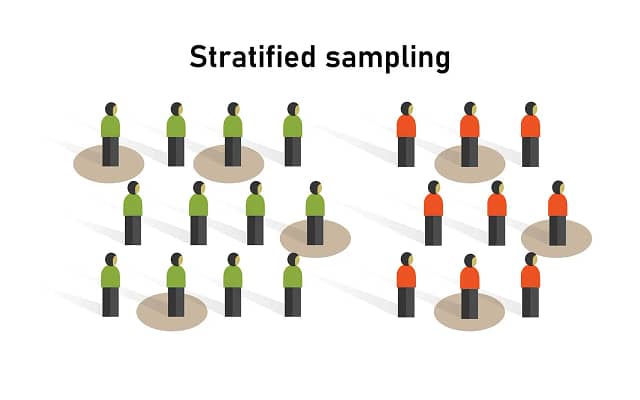Stratified Sampling
Simple random sampling is a type of probability sampling in which the researcher randomly selects a subset of participants from a population. Each member of the population has an equal chance of being selected. Data is then collected from as large a percentage as possible of this random subset
An important objective in any estimation problem is to obtain an estimator of a population parameter that can take care of the salient features of the population. If the population is homogeneous with respect to the characteristic under study, then the method of simple random sampling will yield a homogeneous sample, and in turn, the sample mean will serve as a good estimator of the population
mean. Thus, if the population is homogeneous with respect to the characteristic under study, then the sample drawn through simple random sampling is expected to provide a representative sample. Moreover, the variance of the sample mean not only depends on the sample size and sampling fraction but also on the population variance. To increase the precision of an estimator, we need to use a sampling scheme that can reduce the heterogeneity in the population. If the population is
heterogeneous with respect to the characteristic under study, then one such sampling procedure is stratified sampling

What is stratified random sampling?
In stratified random sampling, a larger population is divided into distinct subgroups, or strata, that share similar characteristics to study their appreciable differences. By dividing the population into strata that share similar characteristics, researchers can draw random samples from each group in proportion to their sizes in the overall population. This ensures that every subgroup is adequately represented, enhancing the accuracy and reliability of the results.
Here are the key steps in stratified random sampling:
-
Identify the Strata: The first step is to divide the population into non-overlapping groups based on specific characteristics, such as age, gender, income level, etc. These groups are called strata. - Determine the Sample Size: Decide how many individuals or items will be sampled from each stratum. This can be proportionate (where the sample size from each stratum is proportional to its size in the population) or equal (where each stratum is sampled equally regardless of its size).
- Random Sampling Within Strata: Conduct random sampling within each stratum. This ensures that every member of a stratum has an equal chance of being included in the sample.
- Combine the Samples: Combine the samples from all strata to form the final stratified random sample.
How to use stratified sampling?
Once you select stratified sampling as your method, follow these systematic steps to ensure your sample accurately represents the subgroups of the population. Here is a detailed guide on how to use stratified sampling:
- Define the Population: The first step in stratified sampling is to define the target population for your research. The complete and exhaustive list of all members of the population should be compiled for this purpose.
- Identify the Strata: Next, divide the population into distinct subgroups, or strata, based on specific characteristics that are relevant to your study. Common characteristics used for stratification include age, gender, income level, education, geographic location, etc.
- Determine the Size of Each Stratum: Calculate the size of each stratum. This involves counting the number of members in each subgroup.
- Decide the Total Sample Size: Decide on the total number of observations you want in your sample; this is basically the number of units you will have in total drawn from each group. This is decided based on the desired level of precision and the resources available.
- Allocate the Sample Size Proportionally: Allocate the total sample size to each stratum based on its proportion in the population. This ensures that the sample is representative of the entire population. Use this formula for proportional allocation:
Applications of Stratified Sampling
Market Research: Stratified sampling is commonly used in market research to ensure that various demographic segments (age, income, gender, etc.) are properly represented when studying consumer preferences.
Healthcare Studies: Stratified sampling helps researchers study populations that have different health characteristics or risk factors, ensuring that various patient groups are accurately represented in medical research.
Social Sciences: Researchers in sociology, psychology, and education may use stratified sampling to study different social, cultural, or educational groups within a population, ensuring that each subgroup’s unique needs or perspectives are considered.
Political Polling: Stratified sampling is often employed in polling to ensure that political surveys include a representative sample of voters from different geographical locations, age groups, and political affiliations.
Steps Involved in Stratified Sampling
Identify the Population: Define the entire population from which you want to draw a sample. This could be a group of individuals, objects, or data points, depending on the study.
Define Strata: Break down the population into mutually exclusive strata. The basis for these strata should be something that is relevant to the research question and is likely to have an impact on the outcome of the study.
Determine the Sample Size for Each Stratum: Decide whether you will use proportional or equal allocation, and then determine how many samples to take from each stratum. This could depend on the size of the strata or the relative importance of the strata to the research.
Random Sampling Within Each Stratum: Perform random sampling within each of the defined strata. This guarantees that individuals are chosen randomly within each subgroup, avoiding biases in selection.
Combine Samples from All Strata: After sampling from each stratum, combine the samples from all strata to create your final sample. The combined sample should be representative of the overall population.
